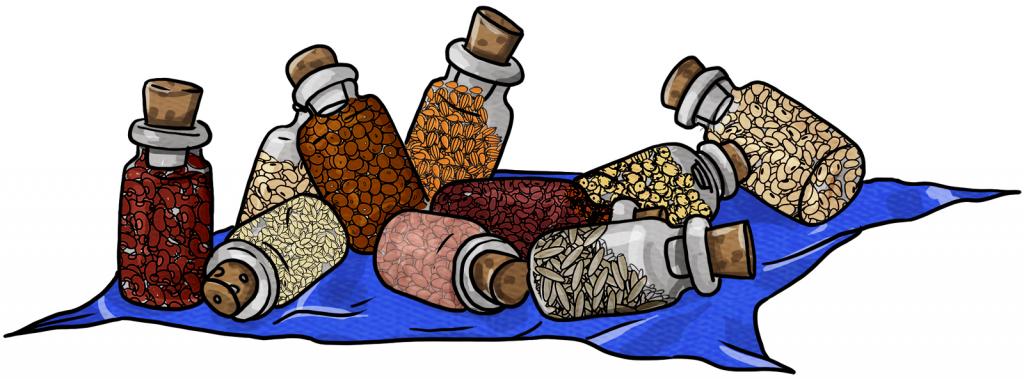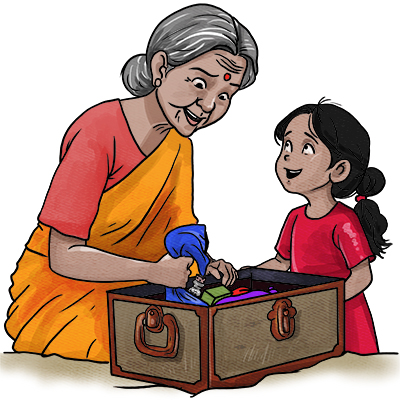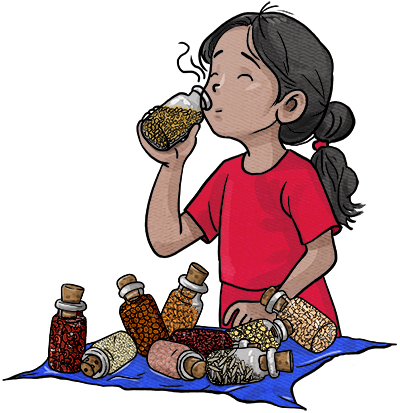
Community seed banks help protect indigenous varieties of food crops which are better at surviving climate change
Summer holidays took Babbi to her grandmother’s house in the rural regions of Uttar Pradesh. One afternoon, when the heat outside forced them indoors, Grandma opened her metal trunk and spread out the knick-knacks so that Babbi could choose one for herself. This was a ritual they followed. Every time Babbi came to visit Grandma she would get a gift from her grandmother’s trunk. As an added bonus, Grandma always had a story to share about the gift.
As Babbi rifled through the spread of knick-knacks in front of her, a bunch of glass bottles caught her eye. They had all sorts of seeds in them. “What are these?” she asked, picking one up to examine. Grandma smiled and told her that this was part of the seed bank she had started when she was around twenty years old. “So can you imagine, some of these seeds must be around fifty years old,” she added. Babbi was fascinated to see these seeds from her grandmother’s past. She could recognize some of the seeds in the ten bottles as rice, rajma (kidney beans), mustard, and arhar (pigeon pea). The bottles also had faded labels indicating where the seeds were collected from.
But something still puzzled her. Looking at her grandmother quizzically, Babbi asked, “What is a seed bank? Aren’t banks for money?” Grandma was more than happy to explain. “For farmers, saving good quality seeds for every year is very important. By planting the right seed, you can ensure that your crop grows well in the prevailing environmental conditions. Storing good seeds also helps farmers ensure a uniform crop and preferred taste of food for many years.”
 “Generally, farmers keep a part of their yield for planting in the next season. If the seeds have interesting and beneficial traits such as the ability to grow without water or in places where the heat is extreme, they are saved for more long term use.”
“Generally, farmers keep a part of their yield for planting in the next season. If the seeds have interesting and beneficial traits such as the ability to grow without water or in places where the heat is extreme, they are saved for more long term use.”
Grandma picked up a small bottle lovingly. “I started my collection with this rice sample which can grow in drought conditions. You must have seen how rice is planted in a pool of water to ensure good growth. But this seed here grows in minimal water.
This is a wonderful variety to grow in areas where getting enough water is difficult. And I was not alone in collecting seeds. Nearly all the farmers in our village collected and preserved seeds. You know how you buy souvenirs when you travel, in those times, people would get seeds of the plants they wanted to grow on their land. Farmers spent decades perfecting plant traits that suited them.”
Gesturing to some of the other bottles, Grandma said, “I managed to collect quite a few seed varieties, as you can see. This rice variety can grow in saline water. This arhar dal grows perennially so you can harvest the pods just like you harvest fruits such as apple. This dal plant can survive for as long as five years, so farmers do not have to spend money on new seeds. The best thing is that you can also harvest the dal as the pods mature. If the whole plant has to be harvested together, you need to ensure that most of the pods on the plant are of the same age. This is difficult and often leads to wastage.”
As Grandma finished explaining this, Babbi had another question ready. “If I plant these seeds, will they grow?”
“These seeds are quite old so we cannot be sure,” Grandma said. “Also, I have just bunged them in a bottle but there are ways to ensure that seeds remain viable for a long time. These techniques too have been perfected over time by the farmers. They used traditional, low-cost storage methods to prevent moisture buildup and fungal contamination. Some farmers store the seeds in earthen pots, bamboo bins and wooden crates, lined with natural pest repellents, such as neem leaves or turmeric powder.
Even simple methods where seeds are stored in between layers of ash and neem leaves to prevent moisture buildup and pests works well. Others used glass bottles and ash to ensure dry conditions for the seed. The seeds were cultivated regularly to ensure availability of new seeds each year.”
 “There are seed banks that store seeds at extremely low temperature to maintain viability. For example, the Indian Seed Vault is located in the cold areas of Ladakh. This one has just around 200 seed varieties. But there are others like the Svalbard Global Seed Vault in the Arctic Archipelago of Norway, which holds over 1.3 million seed varieties from almost every country. Seeds here are stored at a very low temperature of –18 degrees Celsius and the bank is often referred to as the doomsday vault as it can protect us in an uncertain future.”
“There are seed banks that store seeds at extremely low temperature to maintain viability. For example, the Indian Seed Vault is located in the cold areas of Ladakh. This one has just around 200 seed varieties. But there are others like the Svalbard Global Seed Vault in the Arctic Archipelago of Norway, which holds over 1.3 million seed varieties from almost every country. Seeds here are stored at a very low temperature of –18 degrees Celsius and the bank is often referred to as the doomsday vault as it can protect us in an uncertain future.”
As Grandmother rattled out story after story about seed banks, Babbi was filled with awe. She had never imagined a seed could be so precious. She thought back to all the times she had eaten a fruit and thrown away the seed without a second thought.
At that moment, Babbi decided that she too would start a seed bank of her own. But she was not sure if this could still be done and she asked grandma whether community seed banks still existed. Grandmother nodded her head in an affirmative. “The non-profit that your aunt works with recently did a study on seed banks in the country. Their online survey found that even now, across 71 different crops, about 887 climate-resilient varieties are available. And all of these in just the 40 or so seed banks they studied in 15 states. These included seeds which are heat resistant, drought resistant, wind resistant, disease resistant, flood resistant, salinity resistant and so on. In fact, the report found that due to climate change, there is now renewed interest in community seed banks.”
“You know, community seed banks are not just about saving seeds, they are also a farmer’s insurance against hunger, inflation, and climate shocks,” Grandma added. “These seeds are so valuable that there are restrictions to take them from one country to another without permission and there are strict penalties on people who break this law.”
Babbi opened one of the bottles and took a deep breath to take in the smell of the old seeds. The stories really touched her to the core, and she asked Grandma if she could have the bottles. Grandma was happy to give them to her and promptly found a box to keep the bottles in. But she was curious to know what Babbi would do with them and asked her to explain. “First, I will read up about these varieties and then I will try to grow a few in flowerpots at home. These seeds are like a time capsule and trying to grow them would be like being you when you were young,” Babbi smiled. “And then, I will also try to find seeds to add to this collection,” she said and gave Grandma a tight hug.
